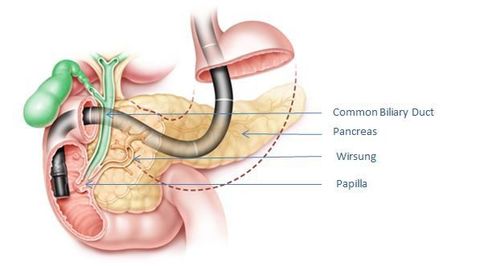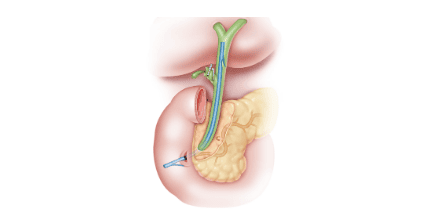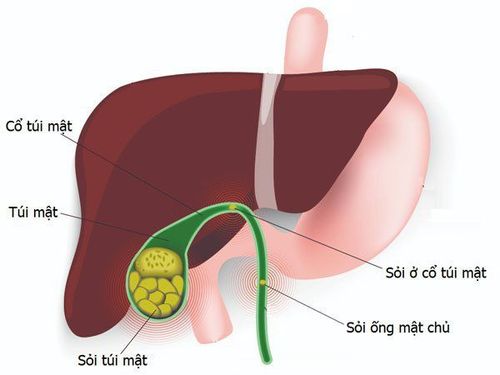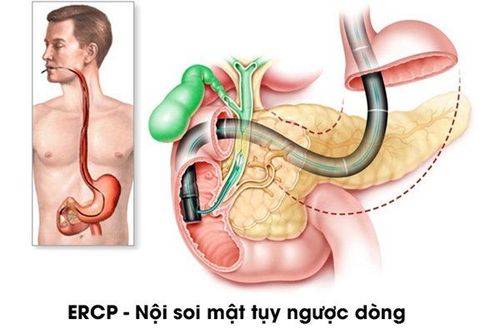This is an automatically translated article.
The article is professionally consulted by Master, Doctor Nguyen Ngoc Thang - Department of General Surgery, Vinmec International Hospital Da Nang.Endoscopic retrograde cholangiopancreatography is a minimally invasive endoscopic technique, used to diagnose and treat many different pathologies such as acute pancreatitis due to stones stuck in the ampulla of Vater, worms in the bile ducts, and choledocholithiasis. ,... Let's learn more about this technique with Vinmec experts through the article below.
1. What is endoscopic retrograde cholangiopancreatography?
Endoscopic retrograde cholangiopancreatography, also known as ERCP, is an X-ray endoscopic technique used to diagnose and treat a number of diseases of the biliary tract and pancreas.The technique is carried out by inserting a catheter into the biliary or pancreatic ducts through a duodenoscope, through which contrast is injected into the biliary or pancreatic ducts for the purpose of diagnosing and treating pathologies of the biliary and biliary tracts. pancreas.
Currently, ERCP technique is mainly applied to treatment, rarely used for diagnostic purposes because there are many diagnostic methods such as abdominal ultrasound, MRI, CT Scanner,... higher level of safety.
2. Why is it called endoscopic retrograde cholangiopancreatography?
Endoscopy is a procedure that uses a device called an endoscope - a small, flexible tube with a small camera and light attached to the end of the tube to help doctors see the internal structures of the body. gastrointestinal tract, including bile duct and pancreatic duct and in the lumen of the duct there is a plastic tube.After inserting the upper endoscope into the duodenum, a plastic tube inside the endoscope will inject contrast material into the duodenal papilla (duodenal papilla is where bile and pancreatic juice pour into the duodenum) , this drug will go up the pancreatic duct and bile duct so it is called "upstream".
Finally, X-rays will take pictures of the pancreatic duct and bile duct, at which time the image of the pancreatic duct and bile duct will be recorded on the X-ray film. This X-ray process is called a cholangiogram.
For these reasons, it is called endoscopic retrograde cholangiopancreatography.
In this technique, it is necessary to use X-ray contrast because when taken with conventional X-rays, the bile duct and pancreatic duct are often not clearly visible on the film. But if X-ray contrast is injected into the lumen of the bile duct and pancreatic duct, the X-ray film will show clear images of these ducts.

Tại sao gọi là nội soi mật tụy ngược dòng?
3. Endoscopic retrograde cholangiopancreatography diagnoses what disease?
Like other techniques, endoscopic retrograde cholangiopancreatography is used to diagnose many different diseases, including:Differential diagnosis of intrahepatic and extrahepatic obstructive jaundice; Suspected bile duct disease but negative results or X-ray cannot be used; Indicated in the case of suspected stenosis of the ampulla of vater in the duodenal papilla; Dilatation of the bile duct, pancreatic duct; Diagnosis of gallstones with dilatation of the common bile duct; Cholangiocarcinoma; Oddi motor dysfunction; Diagnosis of acute pancreatitis due to stones; Endoscopic retrograde cholangiopancreatitis is one of the methods of choice for the diagnosis of chronic pancreatitis, however results may be normal in patients with minimally variable pancreatitis.
4. Endoscopic retrograde cholangiopancreatography is used to treat what disease?
In addition to diagnosis, Endoscopic retrograde cholangiopancreatography is also used to treat:Myotomy of Oddi; Removal of common bile duct stones; Remove pancreatic stones; Nasal bile drainage; Biliary stenting in the following cases: Cholangiocarcinoma in the liver hilum; Cholangiocarcinoma outside the liver hilum when surgery is no longer possible; Benign biliary atresia; Large stones in the common bile duct cannot be removed immediately; Gallstones in the common bile duct, but patients in severe condition do not allow stones to be removed; Biliary tract infection requiring drainage; Placement of a pancreatic stent.
5. When is endoscopic retrograde cholangiopancreatography contraindicated?

Thủ thuật chống chỉ định với bệnh nhân suy tim
Patients with recent myocardial infarction; Severe cardiopulmonary disease; Allergy to contrast agent; Severe blood clotting disorders; Thrombocytopenia; Are taking antiplatelet drugs; Acute cholangitis, except in cases of suspected ductal obstruction (due to gallstones); Acute pancreatitis with suspected or confirmed pancreatic necrosis.













